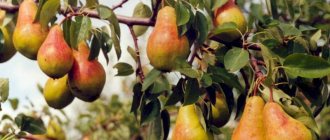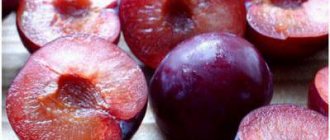How to find out which group clematis belongs to
Clematis are sold in nurseries with the obligatory clarification of which pruning group the selected variety belongs to. There are 2 types of pruning, which combines 3 groups:
- 1-2 is a light pruning, which is necessary for a group of flowers that form flowers on last season's shoots.
- 3 is a strong complete pruning for clematis that blooms only on new shoots.
If the grower does not have information about whether clematis belongs to a certain group, then mixed pruning is carried out in the fall. After wintering the bush, new shoots will appear on it, and when buds form, it will become clear which shoots of which season they are attached to.
Another way to determine the pruning group is to analyze the growing season:
- 1 group. These are plants that begin to bloom in early spring. They do not need to increase green mass, but rather preserve the shoots over the winter. This group does not need pruning; adjustments are carried out after flowering, in the second half of July.
- 2nd group. These plants bloom twice: on last year's vines and on new shoots formed by August. For such varieties, light pruning is provided.
- 3rd group. Most clematis varieties make up this group. Large flowers appear on new growths of the current season. The condition for caring for group 3 crops is complete pruning in the fall.
Methods for propagating clematis in the Urals
Clematis planting material is very expensive. But if there are vines on the site, you can propagate them yourself. To obtain new plants, gardeners in the Urals can use any method:
- seeds;
- layering;
- topping;
- dividing the bush.
All methods are effective and quite appropriate at home.
Attention! Seed propagation is rarely used, since this process is lengthy.
Advantages and disadvantages
The main advantage of clematis of pruning group 3 is the variety of varieties. These include large-flowered clematis, as well as attractive double varieties.
Among the advantages are:
- low maintenance requirements;
- abundant flowering;
- accelerated growth of the bush;
- variety of shades of petals;
- prolonged flowering.
The plants that make up this group remain among the last inhabitants of the autumn garden.
After complete pruning, vine bushes do not take up much space, do not require additional shelter for the winter, and tolerate low temperatures well.
Among the disadvantages, some gardeners mention delayed flowering. To form buds, bushes cut to 20 centimeters need to increase green mass. Those who count on earlier flowering plant clematis of the first group.
The best varieties of clematis 3 pruning groups
Among the vines of group 3, several subspecies are distinguished that have similar features. The classification is based on the size of the flower, the structural features of the stem and the nuances of care.
Large-flowered
All varieties are characterized by the presence of a large number of flowers. New buds appear on the vine immediately after flowering. Varieties with large flowers make up one of the most popular groups when decorating personal plots.
Victory Salute
This variety is named in honor of the victory in the Great Patriotic War of 1941-1945. It is distinguished by late and abundant flowering: it begins to produce buds from the second half of July. The shade of the petals can be lilac, violet, purple. The size of the bud varies from 16 to 18 centimeters.
Space melody
The liana grows up to 3 meters, which makes it possible to use the crop to decorate arches and walls of buildings. The color of the inflorescences is often scarlet, red-violet. The inflorescence size is small, reaching 10 centimeters.
Golden Jubilee
Buds appear in the second half of July. Gradually the petals acquire a purple color, but the center with the pistil remains golden. The liana stretches up to 2.5 meters, the diameter of the bud is 18 centimeters.
See also
Description and characteristics of clematis variety Niobe, planting scheme and careRead
Teal
The stems grow up to 3 meters. At the nodes of new shoots, starting in July, blue buds open. The anther becomes yellow in color. When unfolded, the diameter of the sepals is 18 centimeters. The flowering of this variety is long and abundant.
Smoky
The petals have a characteristic gray-blue color. The structure of the petal is velvety, diamond-shaped in size. The foliage on the stems remains bright green throughout the growing season. The variety is known for its increased resistance to fungal diseases.
Mephistopheles
The species received its name because of the pronounced dark blue, almost black color of the sepals. The diameter of the open cup is about 14 centimeters; the edges of the petals, when fully opened, curl inward from the bottom.
Small-flowered
Particularly popular are liana shrubs strewn with small flowers. From a distance, when placed correctly, they create the illusion of a living flower carpet.
Clematis stinging
The whip grows up to 5 meters long and 2 meters wide. The flowers are small with 4 white petals. The variety blooms in the second half of July and exudes an aroma with characteristic notes of roasted almonds.
Manchurian
The buds are bell-shaped with 4 petals and have a white, less often pink, color. The liana stretches up to 2 meters. The bushes remain compact when grown along a support. The variety is highly frost-resistant.
Princess Diana
Flowering lasts from July to October. The variety is recognized by its unusual color: the pink center of the petal is framed by a white border. The stems grow up to 3 meters, they need to be completely pruned in late autumn due to the formation of a large number of additional shoots.
Princess Kate
A Texas hybrid that blooms throughout the summer. The diameter of the inflorescences is 6 centimeters, the color changes: at the beginning of flowering it is light lilac, towards the end of flowering it darkens, while the middle remains light pink.
Arabella
The peculiarity of the variety is its abundant flowering. It is almost impossible to see the green foliage under the purple flowers. Clematis bushes are small, stretching up to 2 meters, this allows you to grow bushes with or without support.
Vanguard
Pink winter-hardy clematis, bred by British breeders. The petals have a velvety structure, the vines stretch up to 3 meters.
Terry
The texture of this variety makes the varieties especially attractive. The diameter of the sepals of terry varieties can vary.
Purpurea Plena Elegance
The variety is used to cover the soil; for this it is planted in compliance with certain nuances. Clematis covers the garden area with a burgundy carpet from the second half of July to mid-September.
Mazuri
The stems grow up to 3 meters. The color of the petals remains pale blue, slightly spotted throughout the entire flowering period. Additional variety name: Crater Lake. This variety is especially valuable due to its unusual delicate color.
Stasik
Compact bushes reach 2 meters. The petals are noticeable from afar, thanks to their bright wine shade. A less bright thin line runs down the center of the petal. The variety was bred by a private grower and named after one of his sons.
Blue flame
Terry large-flowered blue clematis variety. A white stripe is formed in the center of the sepals. The main part of the flowers is located on the lower part of the bush. When shaded, the variety sharply reduces the release of shoots.
White
White clematis occupy a special place. Among the varieties represented by pruning group 3, the most popular are large-flowered varieties with long stems.
Summer snow
An unusual variety, the shoots of which reach 7 meters. At the new nodes, complex inflorescences are formed, collected in groups of 6. They cover the entire length of the bushes. During flowering, a weak but persistent aroma is heard.
Roko-Colla
A variety bred in Estonia. The liana is 2 meters long and adapts to any type of support: it wraps around a fence, tree trunks, arches. Cream-colored flowers with white centers bloom from July to August.
John Huxtable
The petals of this variety are bright white in color, while the stamens are cream-colored. The bushes reach a height of 3 meters. The foliage remains dark green until flowering begins, then gradually turns pale.
Paul Ferges
Hybrid with buds similar to daisies. The similarity is emphasized by the pronounced yellowish-green middle. The vines have a high degree of tenacity; during the summer months they grow up to 7 meters. This variety is placed in the center of the hedge; in a few weeks it grows in width and covers the entire surface.
Huldin
Large white flowers on long green vines bloom later than all other varieties in this group. The variety is resistant to frost and is not susceptible to fungal infections.
Pink
Pink clematis is often grown in the middle part of the country. Varieties with pink flowers exhibit resistance to low temperatures.
Dunata
Polish variety bred for areas with early frosts. Pink buds reach 12 centimeters in size when fully opened. The shade remains even throughout flowering; the stamens turn bright yellow before flowering.
See also
Description of clematis variety Blue Angel, planting and care rulesRead
Yalta sketch
The variety has received an international certificate of conformity. The flowering of the Yalta etude is characterized by the presence of 2 stages: bright pink buds open in the second half of June, and then in the second half of August. The shade changes depending on the weather: in the bright June sun the petals fade to pale pink.
Hagley Hybrid
The lashes stretch up to 3 meters. The color of the petals varies from bright crimson to raspberry pink. In direct sunlight, the color fades a little around the edges, which makes the appearance even more interesting.
Comtesse de Bouchaud
Lianas grow up to 4 meters. The petals curl along the edges, and at the peak of flowering they turn pink-violet. A dark stripe runs down the center of the sepals.
Pink Fantasy
Bushes are often grown in outdoor containers. Flowering lasts from July to August. The shade of the petals remains consistently pink, while the stamens are colored brown.
Planting clematis in open ground
What time to plant
It is very important to plant clematis in open ground at the right time, and you need to carefully select a suitable site for this. The area suitable for planting must be protected from drafts
You also need a sunny area, but it will be very good if it is in the shade at midday. The soil is suitable for slightly alkaline, nutritious loamy soil; it must also be well-drained and fertilized. This plant is recommended to be planted on a mound or artificially made embankment. As a result of this, the long (about 100 cm) root will not begin to rot due to the proximity of groundwater. You cannot feed clematis with acidic peat or fresh manure. Do not plant the plant next to a fence or building (do not allow water from the roof to fall on the clematis); a distance of at least 0.3 m should be maintained between them.
This crop can be planted in open ground in both autumn and spring. If you purchased a seedling that is in a container, then it can be planted in summer, autumn, and spring. If you purchased planting material in late autumn and were late with planting, then it should be saved until spring. To do this, the seedlings are placed in a cool room (no more than 5 degrees), their root system must be covered with a mixture of sand and sawdust, which should be moistened. To restrain the growth of seedlings, pinching must be done regularly.
Before planting, you need to carefully examine the root system of the plant. If it is dry, it should be immersed in cold water for several hours before planting so that the roots can swell.
Spring planting
If the climate in the region is cool, then clematis is planted in open ground in the spring, or more precisely, in the last days of April or the first days of May. A spring seedling must have at least one stem.
The size of the planting pit should be 0.6 x 0.6 x 0.6 m. At the bottom of the pit it is necessary to make a drainage layer 10 to 15 centimeters thick; for this it is recommended to use broken brick, crushed stone or perlite. If the soil is poor, then this must be corrected by adding 1 bucket of peat and sand, 2-3 buckets of compost, 150 grams of superphosphate and 400 grams of dolomite flour (everything needs to be mixed very well, while experts recommend fertilizing the soil 1 year before landings). For the stems of seedlings, it is necessary to install removable supports (if desired, you can dig in stationary supports), their height should reach 250 cm. The supports are needed to support the plant during strong gusts of wind. On the surface of the drainage layer, it is necessary to pour the soil into a mound, on which the seedling should be installed
After its roots have been carefully straightened, the hole is filled with a pre-prepared soil mixture, taking into account that the root collar should be buried 50–100 mm into the soil, and the shoot trunk should also be in the ground up to the first internode. The hole should not be filled completely; there should be 8 to 10 centimeters left to its upper edge
The planted bush should be watered with 10 liters of water. Then the surface of the excavation near the bush must be covered with a layer of peat. Throughout the spring and summer, the remaining excavation should be gradually filled with soil. When planting, a distance of at least 100 cm must be maintained between plants.
PLANTING CLEMATIS IN AUTUMN - HOW TO PROPERLY PLANT CLEMATIS IN AUTUMN with Nina Petrusha on CLEMATIS TV
Watch this video on YouTube
Autumn planting
In southern regions with a warm climate, this plant is planted in the autumn, or more precisely, in September or October, but the seedling must have developed vegetative buds. It is necessary to plant clematis in the fall in the same way as in the spring, but in this case the planting hole is completely filled with soil. Then the surface of the soil around the seedling must be covered with a layer of dried foliage, and the top should be covered with any covering material, for example, lutrasil. In the spring, it is necessary to remove soil from around the plant to a depth of 8 to 10 centimeters; during the summer period, the resulting depression must be gradually filled with soil. Such depressions are made to make it easier for the stems to break through to the surface of the area.
The best varieties for the Urals
In the Urals, it is customary to grow varieties that are zoned for the climatic zone. The varieties recommended for the Urals are distinguished by frost resistance and a prolonged flowering period.
Gipsy Queen
One of the most popular varieties, it is characterized by frost resistance and resistance to fungal diseases. Purple buds bloom starting in June. The size of the sepals reaches 15 centimeters.
Bella
Bushes up to 2 meters long are covered with yellow flowers that are shaped like stars. Towards the end of the flowering period the shade fades to white.
Rouge Cardinal
The variety is recognized by its large purple flowers with 4 petals. The maximum length that the shoot reaches is 2 meters.
Ville de Lyon
Dark purple flowers bloom from July to August. The bushes grow up to 2 meters. This variety is usually planted along the hedge.
Purple star
The variety was bred in the second half of the 19th century. It is distinguished by the bright purple color of its inflorescences, which are located on compact bushes from August to October.
Viola
Dark purple flowers with pronounced burgundy veins bloom on the nodes of the top row. Flowering lasts from June to October. The only condition for summer care is the timely removal of faded parts.
Clematis 3 pruning groups for Siberia
Clematis for Siberia are chosen taking into account the possible occurrence of return frosts and the onset of early cold weather. This means that the flowering period should be as late as possible, and the variety should be highly resistant to low temperatures.
Jacquemin
Velvety purple petals combined with yellow stamens form inflorescences up to 8 centimeters in diameter. The bushes grow up to 3.5 meters. This variety does not require special care.
Luther Burbank
Large flowers with a diameter of up to 25 centimeters acquire a rich purple hue. Bushes are usually used to decorate fences and walls of buildings.
Warsaw night
Large purple buds with sparsely arranged petals bloom on bushes up to 4 meters high. Towards the end of the period the shade becomes dark blue.
Romance
Compact vines with small flowers bloom in the second half of June. The texture of the petal is unusual, corrugated, at the edges the petals curl down.
Minister
Estonian variety of lilac-blue clematis. They are identified by the beautiful wavy pink line that runs down the center of each petal. Lianas are known for their increased tenacity, which allows this variety to be grown near any support.
Landing
Transplanting seedlings must be approached with special responsibility, since they tolerate it with difficulty. The first step is to choose a suitable place for the plant. Planting period - autumn-spring periods. The supports are pre-prepared so that the roots are not damaged in the process.
You need to choose a site with slightly alkaline soil in a sunny, windless place. When several clematis are planted, the distance between the holes should be at least 1 meter.
Soil is poured into a pre-prepared hole, which includes soil, sand, humus and mineral fertilizers. Clematis are planted so that the tillering node is 5-8 cm deep into the soil.
When a plant needs to be planted in an apartment, it is necessary to use a container with a diameter of 60 cm to 0.5 m. Wooden boxes with holes for drainage are suitable for this. You need to add sand, wood ash and organic fertilizers to the soil.
There are low-growing varieties that can also be grown in flowerpots. They should be fed and watered frequently.
Most beautiful
Clematis are in demand when decorating different areas of the garden or park. They are able to make the area attractive and cozy. Flower growers note that among the wide variety of varieties, varieties with unusual colors stand out.
Elegy
Blue-violet buds with a pronounced purple stripe in the center cover the entire length of the vines. Bushes are often planted near gazebos, as they grow quickly and mask any imperfections in buildings.
Victoria
Large pink-red flowers with a pale center stripe and yellow anthers stand out against the emerald green foliage. This variety blooms profusely and lasts from July to the end of September.
Nikolay Rubtsov
Purple inflorescences with a wavy edge appear twice during the summer. The first bloom occurs in June, then the buds turn pale and wither from the heat. The second time they bloom in the second half of August and remain on the bushes until October.
Ernest Markham
Bright red flowers bloom on the bushes in July. The bushes grow up to 2 meters, then stop growing. This variety blooms profusely only if it is completely pruned in the fall.











